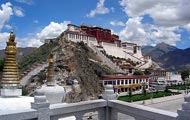The history of Buddhism in Tibet begins with Bon. The Bon religion of Tibet was animistic and shamanistic, and elements of it live on today, to one degree or another, in Tibetan Buddhism.
Although Buddhist scriptures may have made their way into Tibet centuries earlier, the history of Buddhism in Tibet effectively begins in 641 CE. In that year, King Songtsen Gampo (d. ca. 650) unified Tibet through military conquest and took two Buddhist wives, Princess Bhrikuti of Nepal and Princess Wen Cheng of China. The princesses are credited with introducing their husband to Buddhism.
Songtsen Gampo built the first Buddhist temples in Tibet, including the Jokhang in Lhasa and the Changzhug in Nedong. He also put Tibetan translators to work on the Sanskrit scriptures.
Guru Rinpoche and Nyingma
During the reign of King Trisong Detsen, which began about 755 CE, Buddhism became the official religion of the Tibetan people. The King also invited famous Buddhist teachers such as Shantarakshitaand Padmasambhava to Tibet.
Padmasambhava, remembered by Tibetans as Guru Rinpoche ("Precious Master"), was an Indian master of tantra whose influence on the development of Tibetan Buddhism is incalculable. He is credited with building Samye, the first monastery in Tibet, in the late 8th century. Nyingma, one of the four major schools of Tibetan Buddhism, claims Guru Rinpoche as its patriarch.
According to legend, when Guru Rinpoche arrived in Tibet he pacified the Bon demons and made them protectors of the Dharma.
Suppression
In 836 King Tri Ralpachen, a supporter of Buddhism, died. His half brother Langdarma became the new King of Tibet. Langdarma suppressed Buddhism and re-established Bon as the official religion of Tibet. In 842, Langdarma was assassinated by a Buddhist monk. Rule of Tibet was divided between Langdarma's two sons. However, in the centuries that followed Tibet disintegrated into many small kingdoms.
 Lhasa has always remained the cultural, political and economic centre of Tibet. It is the heart and soul of Tibet, the abode of the Dalai Lamas and an object of devout pilgrimage. The places of interest in Lhasa include the Potala palace, Norbulinka palace, Jokhang temple, Sera and Drepung monasteries etc. The JOkhang temple and Bharkhhor circumambulation circuit , full of pilgrims from all over Tibet ,innumerable shops and wayside peddlers selling everything from prayer flags to yak skulls is the most amazing of the experience of being in Tibet.
Lhasa has always remained the cultural, political and economic centre of Tibet. It is the heart and soul of Tibet, the abode of the Dalai Lamas and an object of devout pilgrimage. The places of interest in Lhasa include the Potala palace, Norbulinka palace, Jokhang temple, Sera and Drepung monasteries etc. The JOkhang temple and Bharkhhor circumambulation circuit , full of pilgrims from all over Tibet ,innumerable shops and wayside peddlers selling everything from prayer flags to yak skulls is the most amazing of the experience of being in Tibet. Potala dominates the Lhasa skyline from every corner. Originally there were buildings from 640 AD but the present Potala palace was built in 17th century by the fifth Dalai Lama. It has served as the residence of the Dalai Lamas .It is 117 m high, 13 storied and has 1000 rooms. Different sections of the palace houses a great wealth of cultural and art objects of Tibet. Many parts of the palace , now turned to a museum is open for the visitors .
Potala dominates the Lhasa skyline from every corner. Originally there were buildings from 640 AD but the present Potala palace was built in 17th century by the fifth Dalai Lama. It has served as the residence of the Dalai Lamas .It is 117 m high, 13 storied and has 1000 rooms. Different sections of the palace houses a great wealth of cultural and art objects of Tibet. Many parts of the palace , now turned to a museum is open for the visitors .